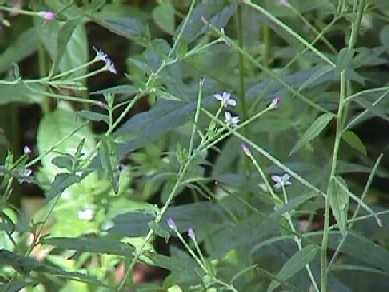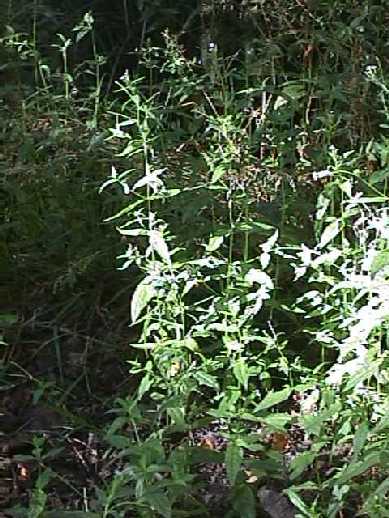

General Species Description
- Watson willowherb is an erect, herbaceous, native, perennial plant growing to a height of 15-150cm. "This species forms a basal rosette of leaves that are initially covered with fine wax powder" (Cooke 1997). It has short rhizomes and the stems appear to be leafy, slightly square, and often reddish when young.
Leaves
- Watson willowherb has many leaves that are opposite, and the shape varies (elliptic to lance shaped). The leaves are reddish to greenish, 3-6mm long, toothed along margins, with short, broad leaf stalks.
Inflorescence/Flowers
- Watson willowherb appears to have white, pink or rose-purple flower (2-8mm long), and has 4 petals and 4 sepals in each. "Sepals are 4-5mm long, and petals are to 8-14mm long , deeply notched" (Cooke 1997).
Fruits
- Watson willowherb forms an inferior ovary which is a pod-like capsule (3-10cm long), elongates to 8cm long, splitting open lengthwise when mature, and producing numerous seeds. Seeds are tiny (1mm) and hairy.
Habitat
- Watson willowherb is "common in moist areas from wet meadows to scrub-shrub wetlands, and often found near the edge of shrub or forested areas which contain small streams" (Cooke 1997).
Range
- Watson willowherb is common in the Pacific Northwest, north to British Colombia. This species is a native to North America.
Similar Species
- Fireweed (Epilobium angustifolium) could be similar to this species, but they are not always found on dry, recently disturbed areas; logged areas, roadsides, etc. Fireweed is also much taller (to 2.5m), has longer and wider leaves, larger and more open flowers, and longer fruits. Young Watson Willowherb is often mistaken with Veronica species as all have reddish, round to slightly square stems and lance-shaped to linear leaves. However, the stems and leaves of the veronicas are creeping, plants root freely at the nodes, and stems lack vertical ridges and are less red.
Ecological Value
- This information was not found.
Human Value
- This information was not found
References
- Cooke, S. S., ed. 1997. A Field Guide to the Common Wetland Plants of Western Washington & Northwest Oregon. Seattle Audubon Society and Washington Native Plant Society. Seattle Audubon Society, Seattle WA, 112pp. B.J. Guard. 1995. Wetland Plant of the Oregon & Washington. Lone Star Publishing, Richmond WA, 175pp Pojar, J. and A. MacKinnon. 1994. Plants of the Pacific Northwest Coast. Lone Star Publishing, Richmond WA, 207pp.
This page was created by: Masamichi Ogasawara, August 1999
Return to Northwest Oregon Wetland Plants Project